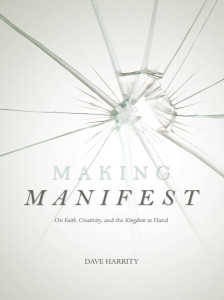Dave Harrity. Making Manifest: On Faith, Creativity, and the Kingdom at Hand. Seedbed Publishing, 2013. 183 pgs. $16.95.
Reviewed by Lynn Domina
Making Manifest: On Faith, Creativity, and the Kingdom at Hand by Dave Harrity is a unique contribution to the set of resources available to contemporary writers. It is on the one hand a writing guide, for it includes a month’s worth of daily writing exercises; on the other hand, it is a devotional book, for it approaches writing generally and poetry specifically from the perspective of a believer, one who interprets his own writing practice as poemia, the creative work of God. God’s creative nature is reflected through creation, and we who have been created as images of God participate in creation and re-creation through our own artistic enterprises. Harrity addresses his readers as Christians, and this book will be most helpful to those who are sympathetic to faith traditions and spiritual practices, of which writing can be one.
In his introduction, Harrity explains the dual identity of the book this way: “The ultimate aim of this book is two-fold: first, to demystify writing practice, but not domesticate it; second, to give you and your faith community the tools you’ll need to create art, live intentionally in and outside your own religious community, and explore the mysteries of your faith through acts of writing, like journaling and poetry” (xiii). The intended audience, therefore, is also at least two-fold: members of faith traditions seeking to enrich their spiritual practices but who might not have significant experience as writers, and writers who are hoping to further integrate their art with their spiritual lives. Many of the exercises are designed for beginning writers, but they can easily be adapted for those with more experience; at the very least, the exercises will assist experienced writers in producing work they would not otherwise have produced. I worked through each of the exercises earlier this summer, and three or four of them have led to drafts of poems that I will be hanging on to (three or four poems emerging from one month’s worth of brief exercises is a much better than average rate for me).
The book is organized into weekly chapters, each opening with a poem. Each day’s section includes a reflection piece as well as a writing exercises, and these exercises are often linked to each other and/or to the opening poem. Some of the exercises focus on content—memories, emotions, observations. Others focus on elements of craft: figurative language, word choice, imagery. I won’t summarize any of the exercises here because their effectiveness often results from the surprise of the sequence of instructions, but I will say that I expect to return to some of the exercises again, tweaking them a little bit each time in order to continue exploiting their strategies.
I worked my way through this book independently, but it could easily be used in a writing group. Harrity has included a section at the end that provides discussion suggestions and further exercises for people who want to use Making Manifest as a guide in writing communities. The book itself and particularly this concluding section is an excellent resource for parishes and congregations, spiritual formation groups, and other small group ministries that focus on spirituality and the arts. I know that I will be recommending the book, as well as Harrity’s affiliated website, http://thisisantler.com/ , in the work I’m currently doing with spirituality and writing.

